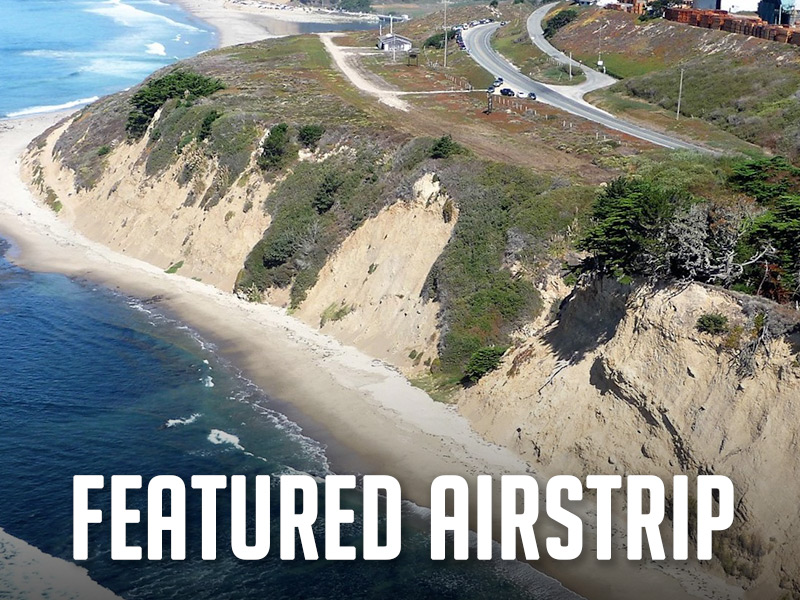FEATURED AIRSTRIP: LAS TRANCAS

Each month we highlight an airstrip with hopes that you will get out and enjoy these special places. This month’s Featured Airstrip is Las Trancas in California.
“It’s hard to put into words how beautiful Las Trancas airstrip is,” RAF President Bill McGlynn says. The strip north of Monterey Bay provides pilots an opportunity to enjoy spectacular Pacific coastal scenery and easy beach access. The 800-foot strip, 17CL lies just 125 feet above the beach. A trail takes you down the cliff to the privately owned seashore where you are allowed to camp.
Owner Big Creek Lumber Company signed a lease with the RAF to preserve this spectacular destination for public use.
Sustainable forestry pioneer Bud McCrary created the strip from which to fly his 1964 Skylane to survey his family’s vast timber holdings and spot fires in the region. RAF Director Tim Riley and local pilots knew the airstrip and Bud, and began earnest discussions about the future of the property before Bud passed. “Without the RAF’s agreement with the McCrary family, this airstrip would have disappeared over time,” Riley said. McGlynn added, “We can’t thank the McCrary family enough for this personal commitment to preserving this airfield and its history for the future.”
In November 2023, RAF California Ambassador Jeremy Lezin reported that Las Trancas “received a much-needed haircut”. He and RAF supporters Barry Porter and Ken Locke-Paddon rented a large Kubota tractor and flail mower to chop down aggressive weeds and bushes surrounding the 800-ft airstrip.
More information and the required safety briefing is available on the Airfield Guide.
Updated February 27, 2024
By Carmine Mowbray

A huge Thank You to the McCrary family, RAF, and everyone who made this possible. This strip is a real treasure. It’s quite demanding so, as the briefing suggests, it’s important to be sharp and current on backcountry technique. With the benefit of the RAF briefing and local knowledge from an experienced Cub pilot who landed just ahead of us, I got to land there for the first time yesterday in perfect conditions. We had great visit and took time to just soak in the sun and take in the incredible surroundings. Looking forward to more happy times and good company at Las Trancas.
Wow, quite the strip. I’ll have to visit it someday.
A lovely spot and the ridge lift at the north end makes any airplane look like a rocket. I wonder if hang gliders still soar the north end.
Yes, Hang Gliders still fly off the North end of the runway. I flew in there a few weeks ago to find gliders on the strip. They soar off the North end and drop back across highway 1 to soar above the Lumber yard. Flying crosswind off the North end when the wind is blowing lets the Hang Glider pilots and the RC glider pilots know you are there so they can get out of your way. They both land on the runway so its good to get their attention before doing an approach.
If you want to see a video of a landing at Las Trancas, watch my YouTube video: “Rancho Murieta to Las Trancas (threat.org airport) 2 06 22”. It is available on my YouTube channel “Jim’s Husky Flying”.
My name is Tim Alentiev and I regularly flew into this strip from 1974-1979. My deceased friend Bob Rorden operated in there with his Cherokee 180 knew Bud McCrary. At that time, it was by permission only. I met Bud and received permission, the only stipulation, land at your own risk. I could almost write a book about this strip and Bud. I always made an approach to the North if there was any wind, and, noted the airspeed loss, if any because of the sink on the south side. Then, I would add that speed to my minimum approach speed. I always landed full stall with the Luscombe and Cessna 140. Bud had a neat system for night landing with his 182. On both runways he had sticks that would break away if hit with reflectors at the top. Because of the geometry, glidepath and azymuth was available if you had a landing light. I made and approach at night once just to see how it worked and it worked great….but, I did not land. Once, operating my 1966 Mooney M-20C, 180HP, which was safe and had safety margins, IF it was light and on minimum speed, a Cessna 140 out of Palo Alto, just out of restoration with a military paint job thought if a Mooney could do it, he could. He did not know that I operated out of there for years. He did everything wrong, too fast, wheel landing, did not track the gravel, went into the Ice Plant with left gear and nosed over! The prop was slightly bent and he was going to fly it out! I said NO and flew hem home. Bud had a direction finder radio and worked with the Coast Guard to take bearings on vessels in distress, and, sometimes did some scouting for them. The original gravel that Bud used was special…..it disintegrated if hit by the prop for no damage. I loved Bud and his strip! I live at S36 near Seattle and fly an RV-6A and RV-10 now. Please contact me if you have any further questions about the history of this strip.
Hi Tim –
Keith Chambers here – Bud’s son-in-law of 40+ years. Thanks for a great and very heartfelt writeup. I think you should reach out to my wife, Carol McCrary Chambers (Bud’s eldest daughter), to communicate on her life with Bud and his airstrip . . . something very dear to her! Because of Bud, she pursued a pilot’s license but only got as far as ground school – i.e. college and I came along!!!